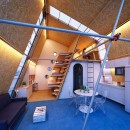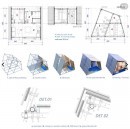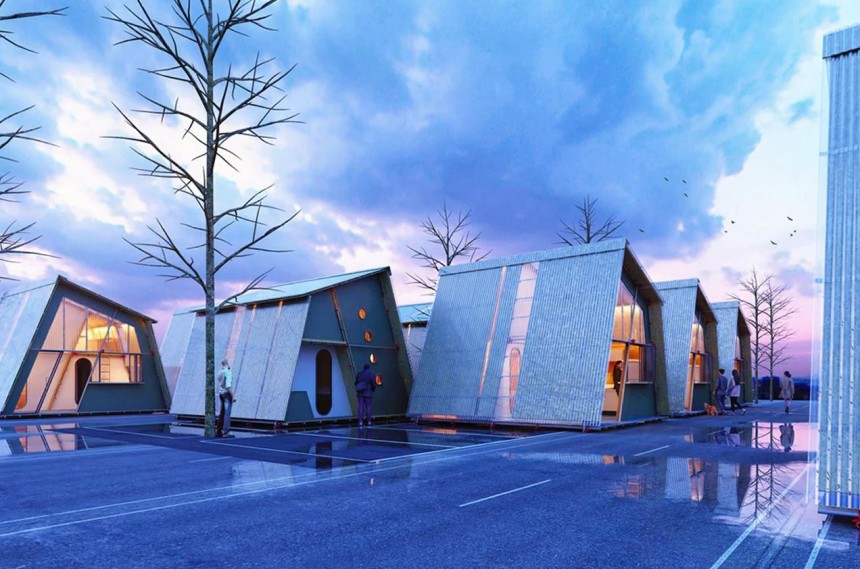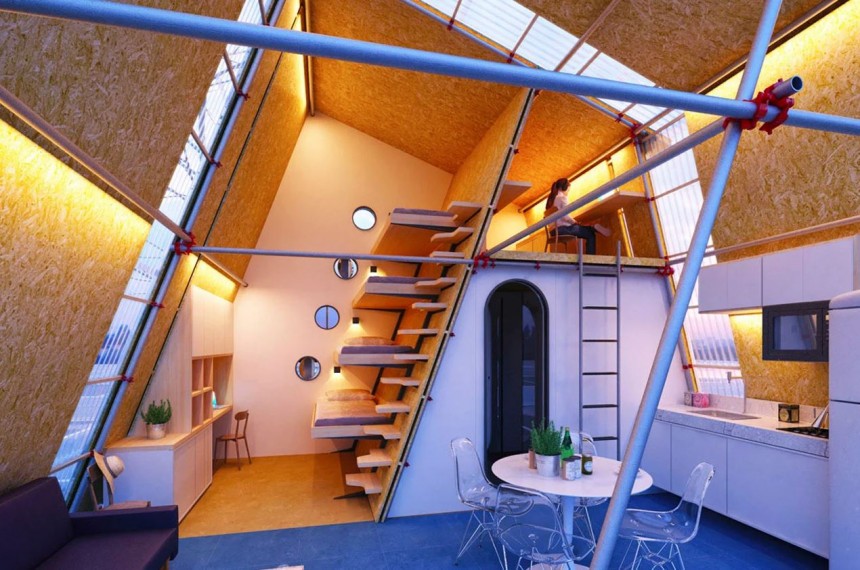Life in any big city is rife with social issues that are both seemingly unsolvable and inter-linked. Whether we’re talking about homelessness, the housing crisis, inadequate or absent infrastructure for personal and public transport, or unemployment, it does feel like there is no proverbial light at the end of the tunnel.
There could be, Brazilian designer Felipe Campolina believes, but only if we reconsider our priorities and start putting man first. Urban Camp, his latest project and one of the honorable mentions at Impact Design Competitions’ Micro Housing 2022 contest, shows how that could be done. Theoretically, for the time being.
We should probably start by saying that this project, though noble in goal and beautiful in its conceptualization, goes against everything you, the reader, stand for. That’s because Camp Urban was conceived for car-centric cities (so, the vast majority of big urban conglomerations), where it would remove cars, in order to make room for humans again. Or, as the designer explains it, it’s “a manifesto against car culture.”
“It’s like a manifesto against car culture by occupying parking spaces and making them habitable for a temporary or permanent situation,” Campolina says. “In addition to fulfilling its role in the housing deficit, this action aims to awaken people’s interest in urbanism for cities that privilege people more than cars.”
Whereas we’re used to seeing vast parking lots used for (duh!) parking cars, Camp Urban would turn these spaces into micro-villages for the homeless, either on a temporary or permanent basis. It would do so using prefab structures built with all the comforts and even the look of a proper home (none of that container homes-type of business!), and would do so in a surprisingly small footprint. Each unit could house at least four people, so a medium-size parking lot could easily become a community of at least 100 people living in just 25 such structures, neatly stacked one next to the other.
Such a prefab unit would use Tube & Clamp scaffolding as the main structure, with wooden lumbers and OSB boards for the walls, and polycarbonate tiles for the roof. Inside, there would be 32.4 square meters (349 square feet) of living space across two levels, with everything from a full kitchen and a bathroom, to a bedroom and an office or study room. Built-in furniture would save up space and provide the basics for a comfortable and, dare we say it, quite elegant life.
You enter directly into the living room, with the bedroom at the side. To save space and create a “unique spatiality,” the four bunk beds are suspended onto the wall, going all the way up to the ceiling and accessible by means of floating stairs.
On the other end is the kitchen and a bathroom; there are no renders for the latter, but the designer mentions that it’s connected to an outside service area. Over the bathroom is the office, and there’s another smaller desk in the bedroom. In short, this tiny home would offer enough room for both the parents to work from home and the kids to do their homework, with the possibility to add an interior wall for more privacy.
Campolina says each unit would be delivered on-site in DIY molds, which means setting it up would be a matter of hours, since there would be no need for digging for the foundation. The biggest challenge would be getting a parking lot and the approval to set up camp on it. Not surprisingly, that’s the biggest flaw in the project as well.
As much as we’d all love to see issues like homelessness solved or, at the very least, addressed so as to not be as severe as they are today, there’s little probability it could happen at the expense of our cars. Certain countries already have car-free zones in big cities, but those battles were not won easily. Imagining a future in which we void parking lots of cars to build micro-villages is idealist at this point, nearly verging on naive.
We should probably start by saying that this project, though noble in goal and beautiful in its conceptualization, goes against everything you, the reader, stand for. That’s because Camp Urban was conceived for car-centric cities (so, the vast majority of big urban conglomerations), where it would remove cars, in order to make room for humans again. Or, as the designer explains it, it’s “a manifesto against car culture.”
“It’s like a manifesto against car culture by occupying parking spaces and making them habitable for a temporary or permanent situation,” Campolina says. “In addition to fulfilling its role in the housing deficit, this action aims to awaken people’s interest in urbanism for cities that privilege people more than cars.”
Such a prefab unit would use Tube & Clamp scaffolding as the main structure, with wooden lumbers and OSB boards for the walls, and polycarbonate tiles for the roof. Inside, there would be 32.4 square meters (349 square feet) of living space across two levels, with everything from a full kitchen and a bathroom, to a bedroom and an office or study room. Built-in furniture would save up space and provide the basics for a comfortable and, dare we say it, quite elegant life.
You enter directly into the living room, with the bedroom at the side. To save space and create a “unique spatiality,” the four bunk beds are suspended onto the wall, going all the way up to the ceiling and accessible by means of floating stairs.
On the other end is the kitchen and a bathroom; there are no renders for the latter, but the designer mentions that it’s connected to an outside service area. Over the bathroom is the office, and there’s another smaller desk in the bedroom. In short, this tiny home would offer enough room for both the parents to work from home and the kids to do their homework, with the possibility to add an interior wall for more privacy.
As much as we’d all love to see issues like homelessness solved or, at the very least, addressed so as to not be as severe as they are today, there’s little probability it could happen at the expense of our cars. Certain countries already have car-free zones in big cities, but those battles were not won easily. Imagining a future in which we void parking lots of cars to build micro-villages is idealist at this point, nearly verging on naive.












